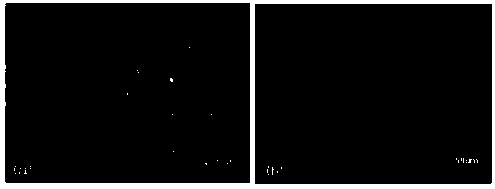Method for capturing tumour cells by utilizing microflow chip
A tumor cell, microfluidic chip technology, applied in the direction of tumor/cancer cells, animal cells, vertebrate cells, etc., can solve the problems of loss, difficult to achieve cells, different expression levels, etc., and achieve the effect of good activity
- Summary
- Abstract
- Description
- Claims
- Application Information
AI Technical Summary
Problems solved by technology
Method used
Image
Examples
Embodiment 1
[0043] use as Figure 5 The microfluidic chip shown captures tumor cells, and the microfluidic chip is as image 3 Shown includes a substrate 1100 and a cover sheet 1200, wherein the substrate 1100 is as figure 2 and Figure 4 It includes: a concave part 1101, a barrier part 1102 surrounding the concave part 1101, and a first channel 1103 connected to the barrier part 1102. The top of the barrier part 1102 is separated from the cover sheet 1200 by a certain distance, which is greater than that of blood cells. The diameter is smaller than the diameter of tumor cells, and the distance between the top of the barrier part 1102 and the cover sheet 1200 is preferably greater than 6-8um and less than 15-25um. Among them such as Figure 4 The barrier part 1102 shown is ring-shaped, and an outlet is arranged on the barrier part 1102, and the outlet is circular. A microcolumn array is disposed in the recessed part 1101 , and the top of the microcolumn array is connected to the cove...
Embodiment 2
[0045] use as Figure 5 The microfluidic chip shown captures tumor cells, and the microfluidic chip is as image 3 Shown includes a substrate 1100 and a cover sheet 1200, wherein the substrate 1100 is as figure 2 and image 3 It includes: a concave part 1101, a barrier part 1102 surrounding the concave part 1101, and a first channel 1103 connected to the barrier part 1102. The top of the barrier part 1102 is separated from the cover sheet 1200 by a certain distance, which is greater than that of blood cells. The diameter is smaller than the diameter of tumor cells, and the distance between the top of the barrier part 1102 and the cover sheet 1200 is preferably greater than 6-8um and less than 15-25um. Among them such as Figure 4 The barrier part 1102 shown is ring-shaped, and an outlet is arranged on the barrier part 1102, and the outlet is circular. A microcolumn array is disposed in the recessed part 1101 , and the top of the microcolumn array is connected to the cover...
Embodiment 3
[0047] use as Figure 5 The microfluidic chip shown captures tumor cells, and the microfluidic chip is as image 3 Shown includes a substrate 1100 and a cover sheet 1200, wherein the substrate 1100 is as figure 2 and image 3 It includes: a concave part 1101, a barrier part 1102 surrounding the concave part 1101, and a first channel 1103 connected to the barrier part 1102. The top of the barrier part 1102 is separated from the cover sheet 1200 by a certain distance, which is greater than that of blood cells. smaller than the diameter of tumor cells. Among them such as Figure 4 The barrier part 1102 shown is ring-shaped, and an outlet is arranged on the barrier part 1102, and the outlet is circular. A microcolumn array is disposed in the recessed part 1101 , and the top of the microcolumn array is connected to the cover sheet 1200 . The substrate 1100 includes a set of first channels 1103 . The substrate 1100 includes a second channel 1104 connected to the first channel...
PUM
 Login to View More
Login to View More Abstract
Description
Claims
Application Information
 Login to View More
Login to View More - R&D
- Intellectual Property
- Life Sciences
- Materials
- Tech Scout
- Unparalleled Data Quality
- Higher Quality Content
- 60% Fewer Hallucinations
Browse by: Latest US Patents, China's latest patents, Technical Efficacy Thesaurus, Application Domain, Technology Topic, Popular Technical Reports.
© 2025 PatSnap. All rights reserved.Legal|Privacy policy|Modern Slavery Act Transparency Statement|Sitemap|About US| Contact US: help@patsnap.com



